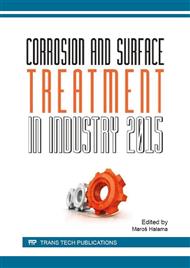p.89
p.97
p.103
p.106
p.115
p.125
p.133
p.141
p.146
Grey Anodizing of a Grade 5 Titanium Alloy: Study of Process Parameters
Abstract:
Anodizing is one of the most promising surface treatments for lightweight metals as titanium because it can increase wear and corrosion-resistance, as well as provide aesthetic appearance and electrical insulation.Three different types of anodizing can be performed on titanium alloys: type I for elevated temperature forming, type II as anti-galling application and type III for coloured surfaces. The type II anodization, called also grey anodizing, is often requested in aerospace or biomedical applications. It is characterized by the use of alkaline electrolyte and it is standardized according to the SAE AMS 2488D norm. However, in literature it is difficult to find information about the process parameters of grey anodizing.In this work, different parameters of the grey anodizing process on a grade 5 titanium alloy were investigated and optimized, in order to obtain an anodized layer with the desired properties, in terms of corrosion resistance, thickness of the coating and wear properties. In particular, the effect of current and voltage applied, treatment time, temperature and electrolyte composition on the characteristics of the anodized layer was studied.The thickness, the composition, the morphology and the adhesion of the protective layers were characterized by SEM/EDS analysis. The chemical and phase composition were analyzed by XRF and XRD techniques. The corrosion resistance of the samples was investigated by potentiodynamic polarization and electrochemical impedance spectroscopy tests. The best results were obtained using as electrolyte a solution containing sodium hydroxide, titanium dioxide, sodium silicate and activated charcoal, with the formation of an anodized layer mainly constituted by titanium oxides and silicates. Intermediate treatment times and ambient temperature were the best conditions to produce the anodized layer. The sample with the best performances showed a homogeneous protective layer about 5 μm thick and was characterized by a lower corrosion current density, higher corrosion potential and polarization resistance, compared with the other anodized samples.
Info:
Periodical:
Pages:
115-124
Citation:
Online since:
March 2016
Authors:
Keywords:
Price:
Сopyright:
© 2016 Trans Tech Publications Ltd. All Rights Reserved
Share:
Citation:


